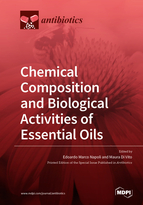Chemical Composition and Biological Activities of Essential Oils
A special issue of Antibiotics (ISSN 2079-6382). This special issue belongs to the section "Plant-Derived Antibiotics".
Deadline for manuscript submissions: closed (15 November 2020) | Viewed by 51202
Special Issue Editors
Interests: natural compound chemistry; green chemistry; agro-industrial waste valorization; analytical chemistry; phytochemistry
Special Issues, Collections and Topics in MDPI journals
Interests: essential oils; microbiology; human physio-pathology
Special Issues, Collections and Topics in MDPI journals
Special Issue Information
Dear Colleagues,
Essential oils extracted by distillation or hydrodistillation of aromatic plants are a complex mixture of volatile compounds with several biological activities. Their efficacy as antimicrobial agents is related to the activity of several components belonging to different chemical families that can act both in synergy with each other and with other antibiotics. The antibiotic resistance detected among pathogens is quick rising in the latest years, and the control of some of these microorganisms is becoming a planetary emergency for human and animal health. The control of the microbial growth is a problem of great importance also for the food industry (food deterioration and shelf life extension) and for the world of cultural heritage (indoor and outdoor phenomena of biodeterioration). Essential oils can play an important role in this scenario, due their recognized broad-spectrum antimicrobial activity. Therefore, the main subject of this Special Issue includes any essential oil-based approach to control microrganisms in areas such as human and veterinary medicine, entomology, food industry, agriculture, and cultural heritage. In addition, manuscripts concerning other essential oils areas of interest are welcome, such as:
- Chemical composition of essential oils from endemic and rare medicinal/aromatic plants;
- Innovative formulations and nanoformulations of essential oils;
- Applications in human and veterinary medicine: e.g. anticancer, antiviral, antinflammatory, analgesic activities of essential oils;
- Use of essential oils as animal feeding supplements;
- Toxicological studies.
Dr. Edoardo Napoli
Dr. Maura Di Vito
Guest Editors
Manuscript Submission Information
Manuscripts should be submitted online at www.mdpi.com by registering and logging in to this website. Once you are registered, click here to go to the submission form. Manuscripts can be submitted until the deadline. All submissions that pass pre-check are peer-reviewed. Accepted papers will be published continuously in the journal (as soon as accepted) and will be listed together on the special issue website. Research articles, review articles as well as short communications are invited. For planned papers, a title and short abstract (about 100 words) can be sent to the Editorial Office for announcement on this website.
Submitted manuscripts should not have been published previously, nor be under consideration for publication elsewhere (except conference proceedings papers). All manuscripts are thoroughly refereed through a single-blind peer-review process. A guide for authors and other relevant information for submission of manuscripts is available on the Instructions for Authors page. Antibiotics is an international peer-reviewed open access monthly journal published by MDPI.
Please visit the Instructions for Authors page before submitting a manuscript. The Article Processing Charge (APC) for publication in this open access journal is 2900 CHF (Swiss Francs). Submitted papers should be well formatted and use good English. Authors may use MDPI's English editing service prior to publication or during author revisions.
Keywords
- Essential oils
- antibacterial activity
- antifungal activity
- anticancer activity
- nanoformulations
- toxicology








